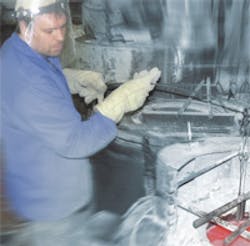Modified Case Hardening Limits Distortion for Steel Vanes
A global manufacturer of air-vane motors has developed its own heat-treatment technique for the steel rotors that are a fundamental component of its units. Deprag Schulz GmbH & Co. () uses a modified case hardening process to enhance the strength and durability of the rotors, similar to methods used for high-wear, lowcarbon steel gears, shafts, or other special purpose tooling components.
Air motors have a simple operating principle. In an eccentric cylinder, compressed air sets the rotor in motion. There are vanes within the rotor slots that are push air outward against the edge of the cylinder wall by centrifugal force. As the compressed air expands the pressure is transformed into kinetic energy, generating the rotational movement.
A 120-W air vane motor is estimated to rotate 11,000 times/minute under load. After 1,000 hours of operation, when the vanes would be changed for the first time, the rotor will have turned on its axis 660 million times.
To endure the constant motion under pressure, the motors require rotors that are sturdy and resilient, for long service life. Prior to hardening, the vane’s rotor structures are machined to final dimension. Deprag’s specially developed hardening procedures are used to improve the steel microstructure, to increase its mechanical durability.
The next step involves immersing the steel rotor in a salt bath at temperatures of up to 950°C / 1,742°F and held there for a predetermined period. Salt-bath heat treatment increases the steel’s mechanical characteristics, rigidity, wear resistance, and core ductility. Load capacity also is enhanced, and resilience to stress and overload tolerances is improved.
The bath carburizes (enriches with carbon through diffusion) the steel’s surface layer. The carbon content in the salt bath is well regulated to ensure consistent results. The typical case depth is 00.5-1.5 mm.
After carburizing, the next step is to harden and temper the rotor. During hardening the steel is heated to the austenite phase (above 723°C / 1,333°F) and then quenched to circumvent the pearlite and ferrite phases, in order achieve a martensite microstructure. Hardening is followed by tempering (a regulated reheating of the material at up to 700°C / 1,292°F to restore an element of strength and ductility to the steel.
Annealing, another heat-treatment technique with a controlled cooling phase, may be used to induce material properties generally associated with softening and stressrelieving internal material structures to improve ductility and cold-working properties.
Deprag offers its case hardening expertise to other manufacturers, too. It claims that distortion-free hardening is nearly impossible, but that “decades of experience” allow it to minimize distortion. Its heat-treatment technique is certified to DIN EN ISO 9001 standards, and the finished components are quality-certified to Rockwell, Brinell and Vickers hardness tests. Microstructural testing also is offered, mainly for high-volume orders.
